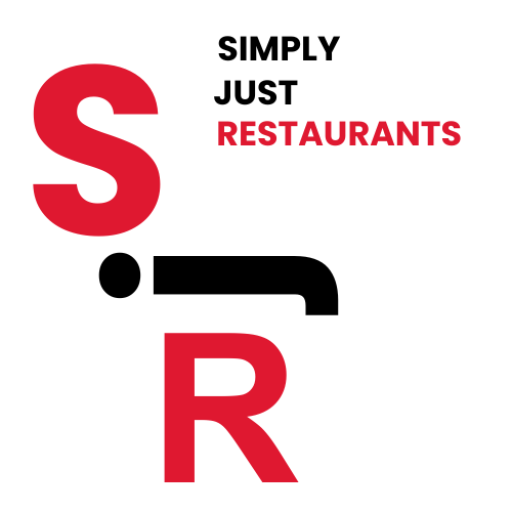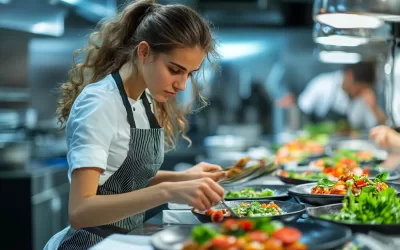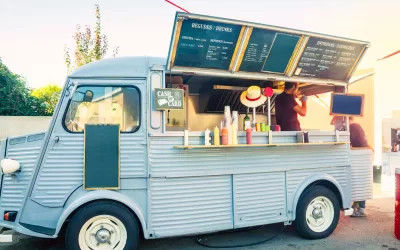Introduction
Designing a bar and restaurant is more than just arranging tables and chairs. It is about crafting a space that marries functionality with aesthetics, ensuring that patrons have a memorable experience while staff can work efficiently. The ambiance, layout, materials, lighting, acoustics, and even furniture all play a significant role in setting the tone for the venue and creating an atmosphere that aligns with the brand’s identity and the dining experience. This guide will explore the essential elements of bar and restaurant design, emphasizing how a well-thought-out space can drive success in the hospitality industry.
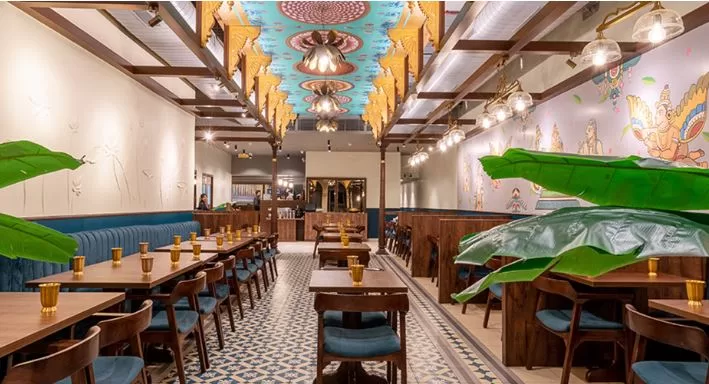
Importance of Thoughtful Design
A bar or restaurant’s design impacts both customer satisfaction and operational efficiency. A beautiful and functional space can make the difference between a one-time visitor and a loyal customer. Below are key reasons why thoughtful design is crucial:
-
First Impressions Matter: The moment a customer walks in, the environment tells them what to expect. Whether it’s a sleek, modern bar or a cozy, intimate restaurant, the design sets the tone for the experience ahead. Patrons will notice the decor, lighting, seating arrangement, and even the layout of the bar, all of which contribute to their first impression.
-
Functionality and Flow: Beyond aesthetics, the design must support smooth operations. The layout should allow servers, bartenders, and chefs to work efficiently without bumping into one another or creating bottlenecks. A well-designed space ensures quick service, reducing wait times and maximizing the number of patrons that can be served.
-
Customer Comfort: An uncomfortable space—whether due to poor seating, bad acoustics, or awkward layouts—can make customers leave sooner than intended or even avoid returning. Designing a comfortable environment is critical to retaining patrons and encouraging longer visits, which can increase overall sales.
-
Brand Identity: The design of your bar or restaurant should communicate your brand identity. Whether it’s a high-end dining experience, a casual sports bar, or a trendy bistro, the space should reflect your brand’s unique personality. Everything from furniture choices to the layout should align with the vision and concept of the business.
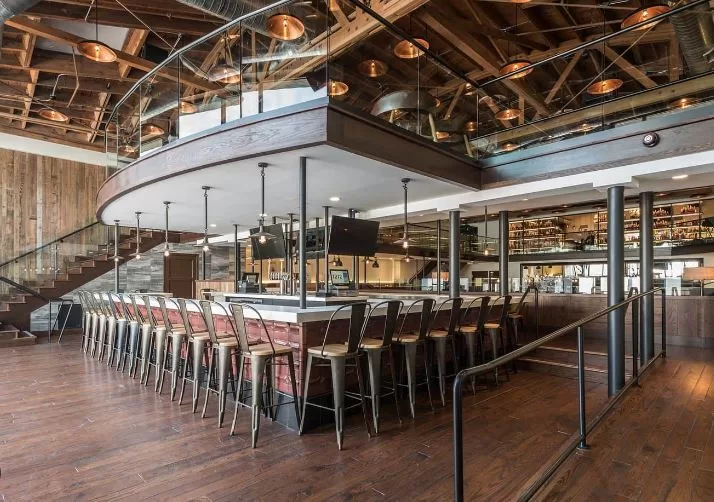
Key Elements of Bar and Restaurant Design
-
Layout and Space Planning: The layout of a bar and restaurant is critical for operational efficiency and customer satisfaction. Proper space planning considers both the front-of-house (dining and bar areas) and back-of-house (kitchen, storage, and service areas).
- Dining Area: The layout of the dining area should accommodate the target number of guests while leaving enough space for circulation. In general, a mix of table sizes (two-tops, four-tops, larger communal tables) gives flexibility. The distance between tables should allow for ease of movement without making patrons feel cramped.
- Bar Area: The design of the bar is particularly important as it serves multiple functions—drinks preparation, customer interaction, and often food service as well. A well-designed bar provides enough space for bartenders to move, store supplies, and make drinks quickly while also being accessible and comfortable for guests.
- Kitchen: The kitchen layout must allow for smooth workflows, with minimal backtracking. A well-organized kitchen reduces the time needed for food preparation and ensures the quality of service.
-
Seating Arrangements: Comfortable and versatile seating is vital to bar and restaurant design. Different seating styles serve different purposes:
- Tables and Chairs: Traditional tables and chairs are a staple in most dining spaces, providing flexibility for various group sizes. Ensure that the chairs are comfortable for extended dining experiences, especially for fine dining.
- Booths: Booths create a sense of privacy and comfort, often encouraging patrons to stay longer. They are great for intimate settings and work well for family-friendly environments.
- Bar Seating: Stools at the bar are perfect for solo diners or those who prefer a more social or casual setting. Bar stools should be comfortable but compact enough to allow for multiple patrons around the bar.
- Communal Tables: In more casual or trendy environments, communal tables promote interaction between guests and are great for small groups or individual patrons. These tables can be a focal point of the dining room or bar area.
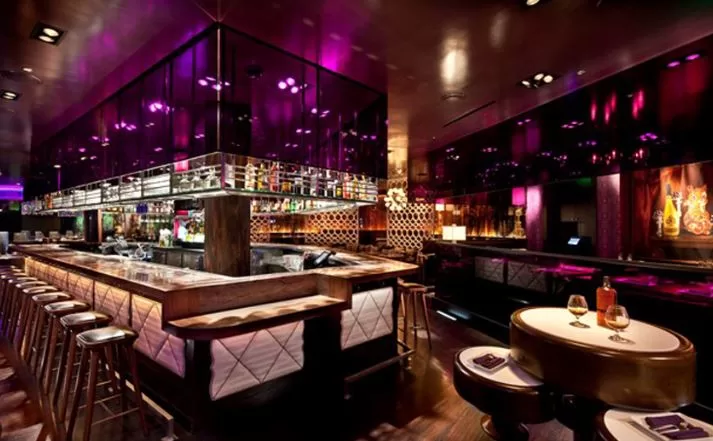
- Lighting: Lighting is one of the most powerful tools in setting the mood for a bar or restaurant. Poor lighting can detract from the dining experience, while well-designed lighting can enhance the atmosphere.
- Ambient Lighting: This sets the overall mood of the space. For a romantic or intimate setting, dim, warm lighting is ideal. For a more energetic, casual atmosphere, brighter lighting can work well.
- Task Lighting: These are lights designed for specific purposes, such as illuminating tables, bars, and food preparation areas. Task lighting ensures that patrons and staff can see what they’re doing without the lighting being too harsh.
- Accent Lighting: Accent lighting draws attention to particular elements of the design, such as artwork, architectural features, or the bar itself. It can add a dynamic and artistic flair to the space.
- Acoustics: Noise levels are a common complaint in restaurants and bars. Good acoustics ensure that guests can enjoy their conversations without being overwhelmed by background noise or music.
- Soundproofing Materials: Acoustic panels, curtains, carpets, and even textured wall coverings can help absorb sound, reducing noise levels and improving the overall atmosphere.
- Music: Background music can enhance the ambiance but must be carefully controlled to ensure it isn’t too loud or too soft. The style of music should align with the concept and brand of the bar or restaurant.
- Material Selection: The materials used in a bar or restaurant impact not only the look and feel of the space but also its durability and maintenance needs.
- Flooring: Floors should be durable and easy to clean, especially in high-traffic areas like dining rooms and bars. Hardwood, polished concrete, and ceramic tiles are popular choices.
- Bar Countertops: Bar surfaces need to withstand heavy use and be easy to clean. Materials like granite, quartz, stainless steel, and even concrete are durable options.
- Furniture: Tables, chairs, and booths should be made from materials that balance comfort, aesthetics, and longevity. Wooden or metal frames paired with upholstered seating provide a nice mix of style and durability.
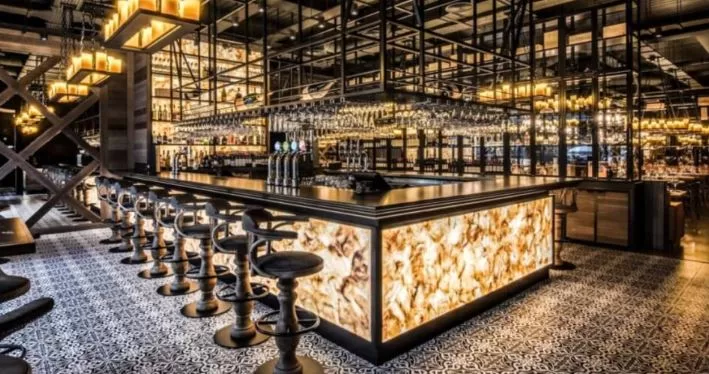
- Color and Texture: The color scheme and textures used in a bar or restaurant play a big role in the overall ambiance. Warm tones like reds, oranges, and browns create a cozy and intimate feel, while cooler tones like blues, greens, and grays are calming and modern.
- Textures: Texture adds dimension to a space. Rough stone walls, smooth polished concrete floors, or soft upholstered seating can create contrasts that are visually interesting. Balance is key—too many textures can overwhelm the space, but just enough can make the design feel dynamic.
- Branding and Décor: The design of a bar or restaurant should reflect the brand’s identity. Whether it’s a vintage, rustic pub or a chic, upscale cocktail lounge, the interior design should communicate the essence of the brand.
- Signage and Logos: The placement of signage and logos should feel natural but still visible enough to reinforce the brand. The design of the signage itself—whether neon, wood-carved, or metal—should match the overall theme of the restaurant or bar.
- Art and Décor: Wall art, plants, sculptures, and other decorative items should be thoughtfully chosen to enhance the atmosphere without cluttering the space. These elements can serve as focal points or conversation starters.
- Sustainability: Sustainability has become a significant consideration in modern bar and restaurant design. Using eco-friendly materials and designing energy-efficient systems not only helps reduce a business’s environmental impact but can also be a selling point for eco-conscious consumers.
- Energy-Efficient Lighting and Appliances: Installing LED lighting and energy-efficient appliances can help reduce energy consumption and lower utility bills.
- Recycled and Sustainable Materials: Using reclaimed wood, recycled metals, or eco-friendly fabrics for furniture and décor is an excellent way to create a sustainable design.
- Outdoor Spaces: Outdoor dining has become increasingly popular, offering a great opportunity to expand seating capacity and create a different dining experience.
- Patio Design: Patios should be comfortable, weather-resistant, and offer shade through awnings, umbrellas, or pergolas.
- Outdoor Bar: If space allows, an outdoor bar can create a relaxed, open-air atmosphere, drawing in patrons who prefer a more casual setting.
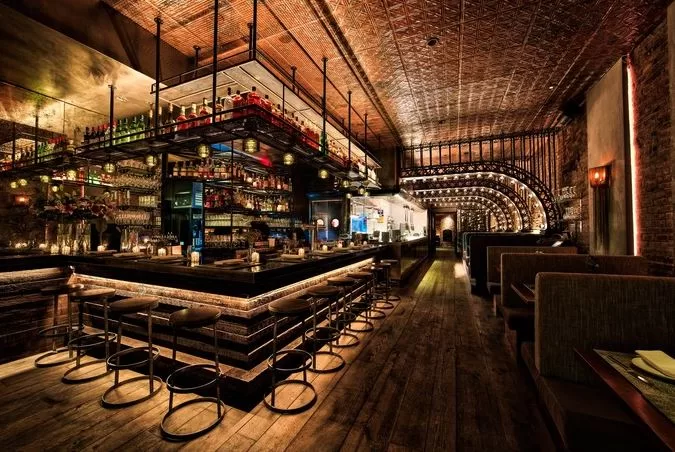
conclusion
Designing a bar and restaurant requires a balance of functionality, aesthetics, and brand identity. From space planning and layout to lighting, acoustics, and materials, every element of the design must work together to create an inviting, efficient, and memorable space. A well-thought-out design not only enhances the customer experience but also contributes to the success of the business by maximizing efficiency and comfort. Whether it’s a cozy, intimate restaurant or a lively, social bar, good design is essential to making a lasting impression and encouraging repeat business.
About Author sudeshna mukherjee
You May Also Like…
The Ultimate Guide to Hiring a Consultant Chef
Introduction Food trucks or mobile food trucks is an idea that has arrived. But, there is a issues with food safety in...
Food Safety Essentials: Addressing 5 Common Problems in Food Trucks
Introduction Food trucks or mobile food trucks is an idea that has arrived. But, there is a issues with food safety in...

